Saving Goals: Caddle team member Ryan
Are you the type of person who can feel cash burning a hole in their pocket as soon as they get it? Or, maybe you hold on to your fun money until you find something worthy of your hard-earned coin?

Either way, it might pay off to have a strategy when it comes to cashing out on Caddle. Ryan, an administrative coordinator at Caddle, prefers to delay spending until something catches his eye:
“As an individual with an ever-changing life and fluid opinions, I’m not after a specific item with my Caddle cash-out. I do however enjoy a nice pile of satisfaction so I believe I’ll wait for more money than the minimum $20.00 ,and knowing myself I will spend that hard earned cash-out on something I want, not something I need due to my paychecks going to what I need. Looking back on this, I’ll probably purchase a video game!”

When it comes to specific strategies, he advises savvy shoppers to make sure they want the item on offer “for a reason other than the Caddle credit. For example, getting an item (you) would normally buy or an item one is planning on trying. If (you) buy just to get the credit, it is almost always a loss of money (ALMOST).”
Survey Results
Valentines Day traditions and gifts
With Valentine’s Day around the corner, we’re in a romantic mood here at Caddle. We’ve been wondering what Canadians are up to on the big day, how they spend time and money with their partner, and whether they had plans to celebrate this day of love.
Valentine’s Day traditions
When it came time to decide how to spend Valentine’s Day 2019, responses were split in a recent Caddle survey; while 25% looked forward to buying presents for their significant other, 21% said they and their honey don’t celebrate Valentine’s Day. Treating their significant other to an experience and being unsure if they will celebrate were tied for third at 19%, while not celebrating at all trailed in fourth place at 15%.
Who is Saint Valentine?
St. Valentine is the patron saint of lovers, epileptics, and beekeepers. By some accounts, he suffered martyrdom during the persecutions of Christians by emperor Claudius II Gothicus circa 270. According to legend, he had signed a letter “from your Valentine” to his jailer’s daughter (who became a friend) and healed her from blindness. Another common legend states that he defied the emperor’s orders and secretly married couples to spare the husbands from war. – Source: Britannica.com
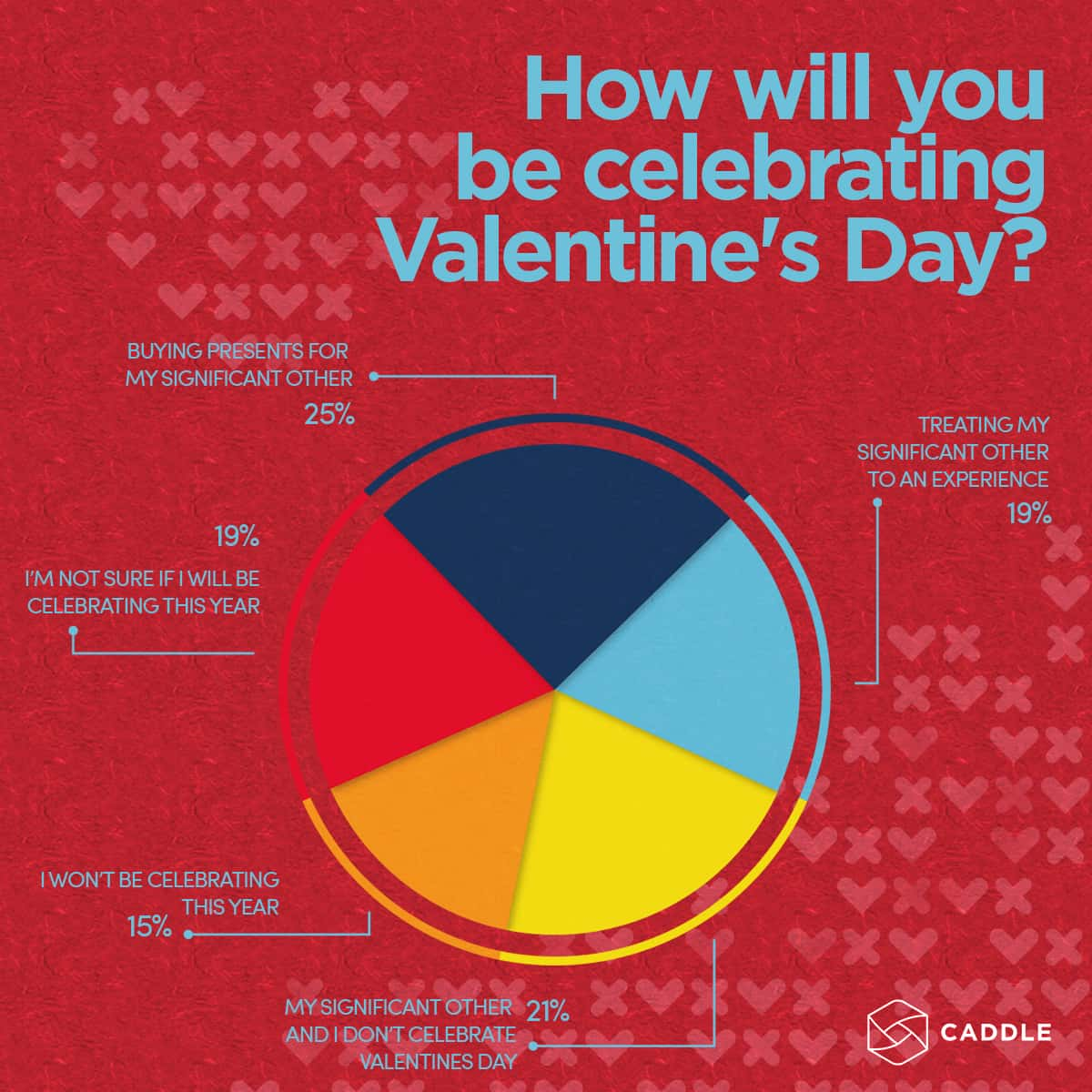
Valentine’s Day gifts
Asked what they think the best way to celebrate Valentine’s Day is, respondents know what they like. Spending time with their significant other was the clear winner at 49%, while “doing something special/being treated to an experience” trailed in a distant second at 22%. Not celebrating Valentine’s Day (10%), “a simple card is good enough for me” (7%), “being showered with gifts” (5%), “gifts, cards, and a special experience” and “Other” ( tied at 3%) rounded out the answers.
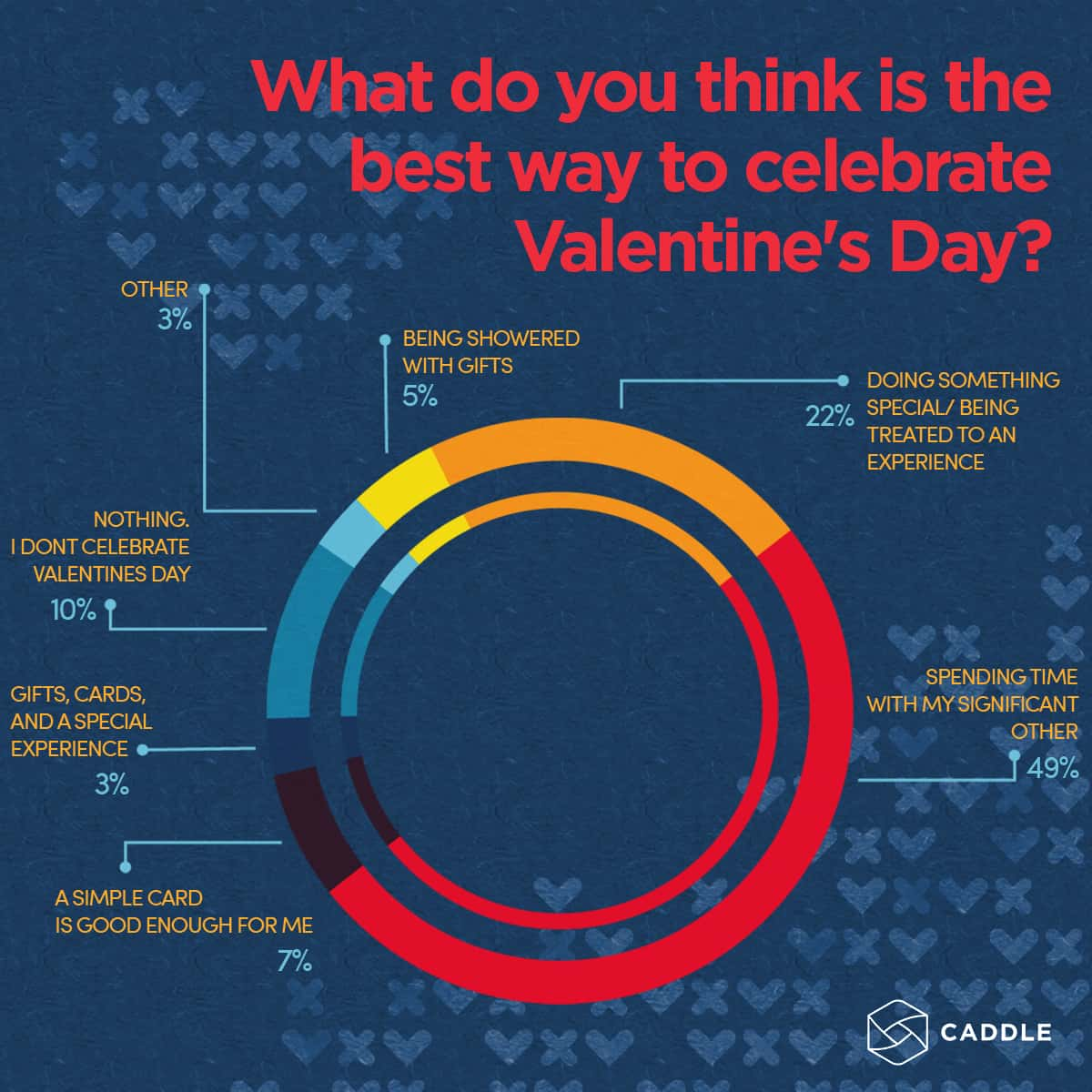
How much to spend on Valentine’s Day?
Once you’ve chosen how you’d like to spend your time and money making memories with the one you love, you’ve got to decide how much to spend. Respondents to this survey are conservative spenders when it comes to Valentine’s Day, with 36% saying one person should spend less than $20. Spending in the $21 to $50 range fell closely behind at 35%, while 16% came in a distant third with a range of $51 to $100. Eight percent fell into the “Other” category, while 5% said $101 to $200, and 1% would go all out at $201 to $500. No respondents said they would spend more than $500.
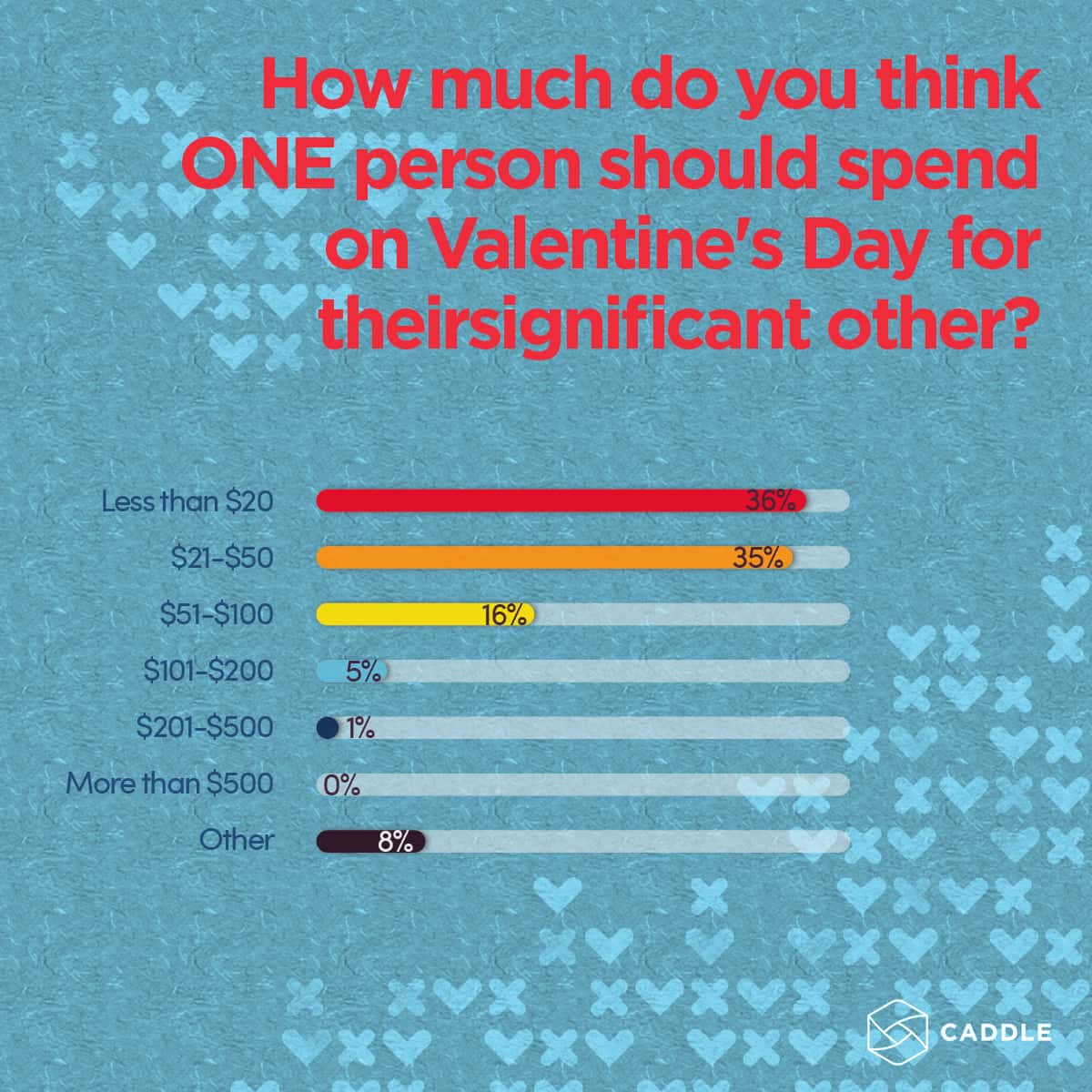
Gifts infused with meaning always win hearts, and our respondents were no different; 29% said the best Valentine’s Day gifts are “something that means something to me”, while 21% would like to be surprised with something they want but probably wouldn’t buy for themselves and 14% were more pragmatic, preferring “something practical.” Following behind were the 13% who don’t do gifts on Valentine’s Day. Traditionalists who prefer flowers or chocolates and “something simple and sweet like a card” tied for fifth place at 11%.
Did you know?
Richard Cadbury, a scion of the Cadburys, a British chocolate manufacturing family, started the tradition of giving a box of candy in the 19th century. The company had recently established a new technique to create more varieties of chocolate, and Cadbury pounced on the opportunity to sell the chocolates as part of the beloved holiday. – Source: History.com

Valentine’s Day Experiences
If you lean more towards experiences, you’ve got lots of options, from meals to a night on the town or even scratching an item off your bucket list. Asked what they think the best Valentine’s Day gifts/experiences are, 35% want “a nice meal together”. The rest of the answers were distant favourites, with 14% looking to book “some alone time without the kids” and 11% wanting “a night with the family”. “A unique night out” and “a meal cooked together” tied for fourth place at 9%. Eight percent don’t do anything for
Valentine’s Day, 6% would love “a night away”, and 4% were in the “Other” category. A “wine tasting/tour” and “something off our bucket list” tied for last place at 2%.
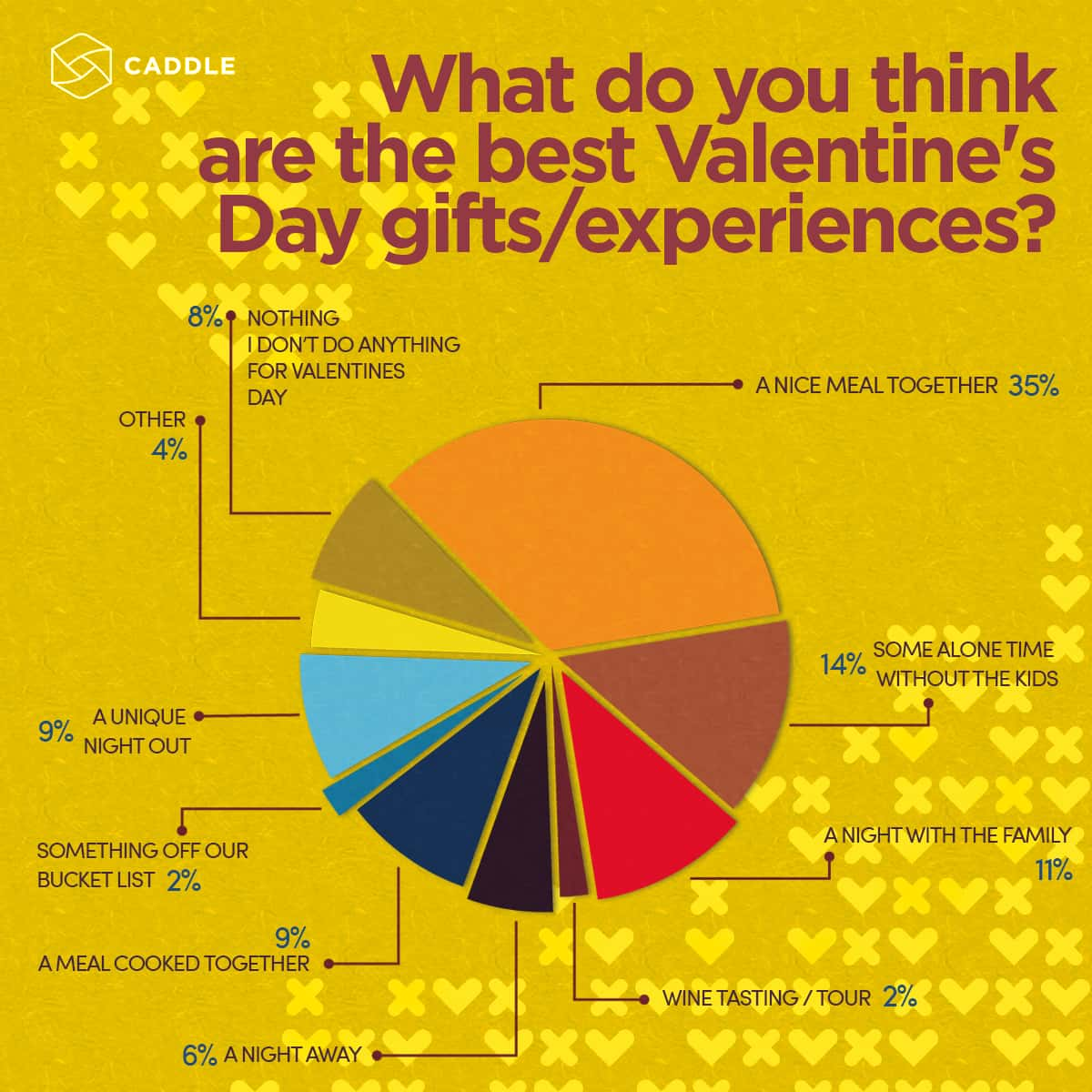
Whether you spend Valentine’s Day with your sweetheart on the town, having a quiet meal in, or surprising them with a gift or experience to brighten their day, what’s really important is expressing how much you mean to each other.
You can create an amazing Valentine’s Day for you and your flame by putting your Caddle cash towards a special gift or crafting an evening just for the two of you. If you’re single, why not take the day for some well-deserved self-care? Start creating your own Valentine’s day traditions today.
Read More: Our Career Survey revealed Canadians want more than just a pay cheque at work.
Australia Travel: Caddle recommends
Travel Australia
Australia has become a mecca for everyone from the most rugged of backpackers and beach bums looking for an escape to paradise to animal lovers, exotic foodies, photographers and thrill seekers.
The world’s largest island and sixth largest country has a sparse population of 24 million spread across 7.6 million kilometres.
The country’s western culture, thriving economy and friendly, welcoming people are similar to North America’s, but the brilliant beauty of everything from the miles of white, sandy coastline on Sydney’s beaches to the bustle of large cities like Sydney and Melbourne to the vast, wild landscapes of the Outback is uniquely its own. You won’t find any other place like this in the world, which is why more than 9 million international visitors visited the country in 2017-2018 , and why tourism is one of the five super growth industries driving Australia’s future prosperity. With those numbers, travel costs have inevitably increased, but you can still find savings if you do your research and plan ahead.

Looking to save? Avoid traveling during Australia’s summer
When you travel to the southern hemisphere, you’ll find seasons are opposite to what you’re used to in the northern hemisphere. Summer is from December through February and winter runs from June through August. Travel + Leisure notes that which region you visit plays a major factor in the weather you’ll see, from high seventies temperatures in the Northern Territory during the winter to cool winters and summers in the low seventies in southern Australia (locales like Adelaide and Melbourne).
If you’re looking to save, avoid the high season from December through February, when prices jump 25% for big-city accommodation. “Shoulder season” is March through May and September through November, and you’ll enjoy warm sun, clear skies and shorter lines, says Lonely Planet.
Tip: Visit the north coast any time from April through October, the south coast and Tasmania from October through April and the Outback September through November or April through June.
Prep for a day-long flight, touch down in a major city.
Be prepared to spend an entire day flying from North America to Australia, which has four main domestic airlines, including Jetstar, Qantas, Tigerair and Virgin Australia. Airnorth (which serves Northern Territory and northwestern West Australia) and Regional Express (which serves Eastern and southeastern Australia) are regional airlines.
Flying into Australia, you’ll probably land in one of the country’s major airports:
- Sydney Airport
- Melbourne Airport
- Brisbane Airport
- Perth Airport
According to sustainable travel blog Drink Tea & Travel, you’ll want to plan at least 6 to 8 months prior to your trip to boost your chances of catching an early-bird price on one of the airlines. Try to fly into one of the main cities listed above to get the best deals.
Public Transport
Take advantage of Oz’s extensive network of public transit, including bike paths and buses. Put your feet to pedals and follow the paths that take you through most major cities, as well as thousands of kilometeres kilometers of country roads. You’re also in luck if you’re a mountain biker – there are many forest trails. Looking for a challenge? Go outback cycling.
You’ll find most buses well-equipped with amenities such as AC, toilets and video screens; they’re also smoke-free and if you’re lucky, you’ll have wi-fi. However, hopping a bus isn’t always cheaper than flying and you may be setting in for a long trip. Also keep in mind that small towns will have a single drop-off/pick-up point (post office, shop, etc.) rather than a bus terminal.
You can also pick up a variety of Greyhound passes that let you travel for a specific number of days on certain routes, including:
- Short Hop Pass (30 days on a variety of routes, ranging from $105 to $229)
- Hop On Hop Off Pass (90 days for long journeys in stages on a route)
- Kilometre Pass (1,000 km for $189 to 25,000 km for $2,675).
See more information about bus routes and ticket prices on Lonely Planet’s guide to getting around Australia.
Though there’s an enormous amount of water around Australia, aside from taking short-hop regional ferries to some of the islands, navigating by boat isn’t usually feasible.

Stay in a dorm or Airbnb, or go camping
Australia’s currency is the Australian dollar (AUD). Nomadic Matt notes the sticker shock many experience when they arrive in Australia, and that the currently strong dollar is virtually on par with the American dollar, meaning Americans get no advantage. The situation is even more dismal for Europeans, with the euro and pound yielding less value for money.
Budget Your Trip suggests you should expect to spend about AUD$188 (CAD$181) per person per day in travel costs on a mid-range budget. For a two-week trip for a couple, you’re looking at AUD$5,263 (CAD$5,053). The travel budgeting site also breaks down the price of accommodation and food, putting accommodation at AUD$80 (CAD$77) and food at AUD$41 (CAD$39) per person per day. Local transportation – taxis, local buses, subway, etc. – was priced at AUD$42 (CAD$40) and intercity transportation – travel between cities – was priced at AUD$140 (CAD$134).
You’ll notice the AUD is close to par with CAD, so there’s no need to convert prices.
Ways to Save
Looking to stay in a specific city on the cheap? UniversityRooms is a cheap alternative to a bed and breakfast or hostel and provides empty, clean and safe university rooms for travellers to bunk in at affordable rates – even if you’re not a student. Choose between bed and breakfast or self-catering rooms. For example, as of January 6, 2019, two adults can each stay in a standard single room at Medley Hall at the University of Melbourne for AUD$80 each from January 27 to February 10. Book a standard double that sleeps two people for AUD$140.
You can also try Airbnb and find a diverse range of properties from a villa in the hinterland to an apartment in Melbourne or a private room in Sydney.
Tip: If you’re hoping to backpack, you’re in luck. Rural Australia offers several gorgeous places to camp. You can also ask to pitch a tent in people’s yards and cook your own food on a portable backpacking stove. – The Broke Backpacker
David Gilbert backpacked through Queensland and Northern Territory for two months about three decades ago, slashing his budget by staying in campsites and hostels for most of the trip.
“Most travel was done by coach bus,” he says, adding, “(There are) long stretches of nothing in the Outback – small ‘towns’ of one family, a petrol station, and a pub as waypoints.”
As he was traveling through the beautiful desert landscape of Ayers Rock (Uluru), the moderate temperatures during the day dropped to below freezing at night, “so you need to have equipment rated for the cold.”
He also cautions that the rock is “quite steep. While there is a guideline, expect your calves to get a workout.”

Safety first
You’ll also want to check your luggage and accessories thoroughly for pests and be cautious around wildlife.
<blockquote"It's important to shake out your sleeping bag before going to bed, and your shoes in the morning, as insects, scorpions and snakes have been known to take up residence. Lots of animal life in Australia will try to kill you, so you have to be cautious."
Tip: Watch out for wildlife. With the largest crocodiles in the world, killer box jellyfish and hairy spiders, extremely deadly cone fish, great white sharks and even boxing kangaroos, there’s plenty to be cautious of. That said, the dangerous creatures here only kill about five people annually. Just be sure to protect yourself, warns y Travel Blog.

Hit happy hours and fire up the BBQ
Although Australia is a popular destination for foodies, a cursory search of travel blogs will tell you it’s expensive, but there are a few hacks you can use to save some of your precious travel budget.
The Smart Gear Blog suggests consulting websites such as Time Out, Broadsheet and The Urban List to find cheap eats for under $10 and daily happy hours in almost every major city in Australia. From there, make a list of all the daily specials and happy hours you plan to hit..
Global Gallivanting recommends taking advantage of the Australian passion for BBQs – most towns have free outdoor BBQ facilities. Grill some lamb burgers with red onion aioli, and kick back with a cold Australian beer.
You can also shop at the large supermarkets like Coles and Woolworths, and pick up some basic supplies for a week for $60. Compare that with eating in restaurants, where you can expect to pay between $15 to $20 for an average email, $5 for a coffee, and $8 to $10 for a beer or glass of wine in a bar.
Explore the waters, discover Melbourne
Snorkel at the Great Barrier Reef
Sure, you can see the reef on the Discovery Channel, but even the brightest of 4k screens can’t do this World Heritage site justice. Millions of eager snorkelers and divers flock to this reef system off the east coast of Queensland annually, and for good reason – as one of the most biologically diverse places on the planet it’s environmentally protected and is home to thousands of species of marine life, from tiny corals and shrimp to sharks and dolphins.

Go behind the scenes at the Sydney Opera House
The iconic Sydney Opera House beckons from the edge of Sydney Harbour. One of the most recognizable buildings of the 20th century, its filled with works of art by visionaries, architects, engineers, artists and more. Backstage tours run daily at 7 a.m., so you’ll have to be up and at ’em for the privilege of getting a behind-the-scenes look at this attraction.
Watch whales in Hervey Bay
If you’ve never been whale watching, you’ll be delighted by the humpbacks’ performance in Hervey Bay just north of Brisbane. This is where the young learn the ropes, so you’re likely to see full aerial displays. As Queensland Blog describes, “Hervey Bay is where you come for Cirque du Soleil of whale behaviour.” Best time to visit is July to November.
Explore Melbourne
Whether you’re looking to enjoy a summer’s evening at the Queen Victoria Night Market, check out some local cafes and street buskers, stop and smell the roses at the botanical gardens or take it easy on the beach, Melbourne has it all. See Where’s Mollie’s Complete Guide to Exploring Melbourne for ideas.

Discover the Outback
Whether it’s jumping into a swimming hole, fishing in the Kimberley Region’s freshwaters, hiking rocky landscapes, watching amazing wildlife or taking in a once-in-a-lifetime stargazing experience, you’ll never forget a journey through the Outback. Driving yourself is an affordable option. You can also take a 2WD or 4WD, a train, or bus.
Of course, this is just a small sample of adventures you could take – see Nomadic Matt’s take on Things to See and Do in Australia and Australian Traveller’s The Outback on a Budget for more ideas.
Tip: Expect to be greeted warmly if you have a Canadian flag on your backpack. Australia and Canada share a kinship as commonwealth countries, and citizens from both locales are known as polite and warm – David
Learn more about traveling in Australia
- Australia – National Geographic
- Sydney’s deeper dimensions – National Geographic
- Diving at the Great Barrier Reef – The Blonde Abroad
- 101 ways to do Australia on a budget – Speedy Booker
- Australia 2018 Trip Recap – Rachael DeVaux
- Welcome to Australia – Lonely Planet
- Australia Travel Guide for 2019 – Nomadic Matt
- How to travel in Australia on a budget – y Travel Blog
- How much does it cost to travel Australia: A budget breakdown
- How to travel Australia on a budget – Culture Trip
- Australia on a budget in 10 days – Australia.com
- Outback journeys – Australia.com
- 20 places in Australia you can’t afford to miss – Travel Triangle
- 14 top-rated tourist attractions in Australia – PlanetWare
- Australia travel guide – Travels of Adam
Where else does Caddle recommend?
Caddle Recommends: German Vacation
Learn more about vacationing in German
Germany is a country where you might take in the picturesque, rolling hillside at a national park one day and breathe in the scent of a spicy sausage being grilled at Oktoberfest the next. Of course, you’ll also look forward to the taste of German beer quenching your thirst on a late September afternoon, or tour the spectacular Neuschwanstein castle. Passionate about history? Visiting the country’s striking World War II and Holocaust memorials is also a must.
There’s no mistaking that there’s a lot to see and do in the nation of more than 82 million people at the heart of Europe . We’ve got some tips on how to travel in the country safely and affordably, so if you’re traveling on a budget, read on.

When to go
If you’re budget-focused, Culture Trip, suggests traveling between mid-January and mid-March, avoiding Carnival in Cologne or Düsseldorf. The last two weeks of October are also an option. Hoping to hit the ski hills? Visit between January and March, where you’ll find some of the best slopes in the world less than 90 minutes from Munich.
The weather changes throughout the year might factor heavily into your plans, along with the activities you’ll get to enjoy. According to Adventure in You, the best time (weather-wise) to to take a German vacation is during Europe’s summer season – April to November. Mid-season is April through June and September to October and brings sunny weather. You’ll also notice the country is quieter during these months, with lower prices except on public holidays.
Airports
Flying into Germany, you’re likely to land in one of the top five busiest airports:
- Frankfurt in Frankfurt/Rhine-Main
- Munich in Munich
- Düsseldorf in Düsseldorf/Rhine-Ruhr
- Berlin Tegel in Berlin, Potsdam
- Hamburg in Hamburg

Bring cash, use public transit and rent a bike
Germany’s currency is the euro, and you’ll want some with you when you land. USA Today says you should get enough to cover immediate expenses such as taxis and snacks. Withdraw more euros at ATMs, which, similar to North America, are everywhere including airports, hotels, train stations and attached to banks (you can also use a bank if you’re comfortable going that route).
Leave your plastic in your wallet, and don’t count on using Apple Pay as it’s not very popular or accepted by most businesses, advises travel blog Travels of Adam. Locals prefer using cash and coin for just about everything. Your second option is an EC card (a debit card usable in Germany).
Affordability
One of the reasons travellers love Germany vacations is for the affordability – those euros go further than in many other countries. Depending on what type of experience you’re looking for while visiting, you should budget anywhere from $40 to $120 a day, with accommodations and activities the top two expenses.
Tip: Your server may tell you what you owe instead of bringing you a bill. When you pay, don’t leave your tip on the table – hand it directly to your server.
Savings Tips
On a backpacker’s budget? Adventure in You breaks down accommodation, food and transportation costs in an easy-to-understand format. Get a dorm for €10 to €30 ($12 to $35) a day. If you’re willing to spend more for more comfortable surroundings, a mid-range hotel room will cost you €60 to €100 ($70 to $120). Grab some street food for €2 to €4 ($2 to $5), or a meal in a restaurant for €15 to €20 ($18 to $25). Budget Your Trip also breaks down the price of food and travel, putting daily travel at €106 ($120), food at €28 ($32) and the average price of a hotel for one week for a couple at €1,491 ($1,686). You can travel locally for €16 ($18) or between cities for €49 ($55). See the breakdown for more information on entertainment, tips and alcohol costs. You can also rent a hostel for €30 to €90, says TripSavvy . HotelsCombined offers price checks on hotels.

Transport
You have a diverse range of options for getting around Germany’s cities and larger towns. In large cities, you’ll find an integrated transit system with trams, U-Bahn (underground subway) trains, S-Bahn (suburban) trains and buses. Speaking of buses, Lonely Planet says they’re “a ubiquitous form of public transport, and practically all towns have their own comprehensive network.”
Sometimes they’re supplemented by the faster trams (Strassenbahnen), which run on their own tracks. Generally, you can purchase a single ticket or day pass for the bus or tram.
Tip: Use GoEuro to compare/book transport options anywhere in Europe.
The country is well-known for being cyclist friendly and you’ll be happy to find you can rent a bike and cruise the dedicated bike lanes in many cities.
Tip: On Sundays, most shops including supermarkets, retail stores, malls, etc. are closed.

See stunning castles
Whether you’re bringing the family for an unforgettable tour of the world power, spending a few days at Oktoberfest or strolling through the vineyards Rhine Valley on your honeymoon, German vacations hold something for everyone.
Europe’s second most populated country is home to the Berlin Wall and several World War II sites , such as the Nazi Party Rally Grounds in Nuremberg, the Holocaust Memorial in Berlin and concentration camps at Dachau, Bergen-Belsen and elsewhere that commemorate Germany’s dark history.
Tour historical sites
You’ll also find stunning castles and cathedrals to capture your wonder and imagination. Aachen Cathedral (aka the Imperial Cathedral), the oldest cathedral in all of northern Europe, was finalized in 935 and is the final resting place for Charlemagne, an eminent medieval ruler. Heidelberg’s Heidelberg Castle is one of Europe’s most famous landmarks and has inspired many artists and poets for centuries.
Ajay Khanna lived in Oestrich-Winkel (a small village near Frankfurt) with some close friends for a month before heading to Poland. He remembers boarding a bus to get to the main city, then hopping on a high-speed train to an airport so they could travel around Europe. The group also rented cars to get to Zugspitze – the highest mountain in Germany – to try skiing for the first time, an activity Ajay describes as “terrifying. I accidentally got on the wrong lift and the only way down was the red or the black path,” he remembers. “I highly recommend Zugspitze, as it was one of the most memorable parts of my trip.”
They also stopped at Neuschwanstein castle, “which was beautiful, basically a castle in the sky. I love winter, and Germany is where I felt right at home because [it’s weather is similar to] Canada’s.”
After spending some time in Europe, Ajay returned to Germany and traveled by bus from Berlin to Warsaw, Poland.
<blockquote"It took us about eight hours and I paid about 12 to 18 Euros round trip. I thought I'd test the bus service as I still had a lot of Europe to see. Berlin was closer to the summer, which was amazing because I got to experience both winter and summer in Germany."
He vividly recalls seeing the Berlin Wall and Checkpoint Charlie, which were both “unbelievable – [there’s] so much history behind these monuments and moments.”
Sip local beer at world-famous markets
After a day of exploring, head to Munich’s famous beer gardens (biergartens) , where you can enjoy some world-class suds on a hot summer’s evening. If you’ve got a science and technology enthusiast in your group, take them to the Deutsches Museum – one of the world’s largest science and technology exhibitions.
Tip: Nudity is common in public spaces such as parks:
<blockquote"Once upon a time, I tried to have a peaceful picnic by the river in Munich’s English Garden (one of the world’s largest city parks). Eating my pretzel was difficult
as an elderly man ran naked, wild and free across the river from me,
periodically bathing himself and flaunting his body like he was Ryan
Gosling on steroids." – Happy to Wander
Happy to Wander also advises nudity is expected and mandatory in many saunas, wellness spas, etc.
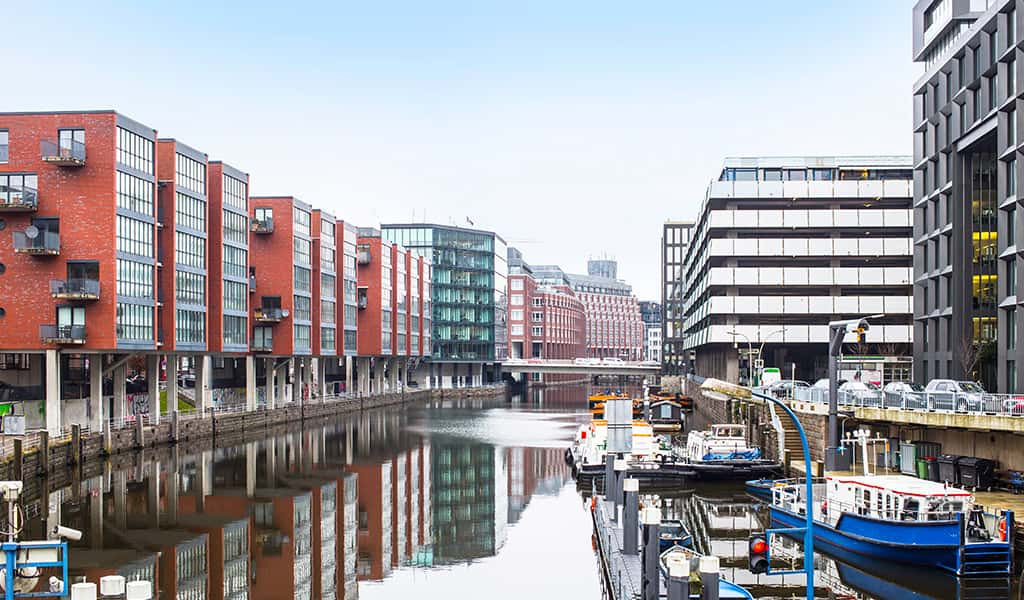
Germany National Parks
At Berchtesgaden National Park, get in touch with nature and hike the trails while enjoying gorgeous scenery of lush forests, crystal clear lakes and sleepy villages. If strolling through a sun-soaked vineyard and cruising the Rhine River by boat is more your speed, take a trip to romantic Middle Rhine Valley. Germany also knows how to host world-famous parties. Oktoberfest – the world’s largest folk fest – brings between 6 to 7 million visitors to Munich at the end of September and beginning of October to indulge in food, entertainment, music and activities for 16 days. Revellers indulge in everything from from sausage, poultry and roasted chicken to suds from local breweries and countless large pretzels.
Germany Christmas Markets
Traveling in late November/early December? You’ll have any number of Christmas markets to look forward to, where Gemütlichkeit (winter cheer) abounds and brilliant sights, sounds and smells await to delight your senses. Marvel at the world’s tallest Nutcracker at the Dresden Streizelmarkt or savor Glühwein, Käsespätzle, the local version of macaroni cheese while you stroll through Old Town Konstanz (there’s also a Christmas ship, moored at the quayside). In the medieval city of Nuremberg, you can enjoy spicy grilled sausages before browsing the handcrafted goods on sale in what is arguably Germany’s most famous Christmas market.
From medieval castles and the Middle Rhine Valley to the raucous Oktoberfest that brings millions of revellers to Munich every September to indulge in delicious German food and local beer, to its world-famous Christmas markets, and the striking memorials to World War II, you’ll always have new sights to see and new places to discover on your German vacation – all on an affordable budget.
German Vacations
Don’t forget to tell us about your experience! Have you ever traveled to Germany or are you planning to book a trip? What are your best tips when it comes to saving for vacations? We’d love to hear what you’ve planned, or any tips we’ve missed. Share your story in the comments and tell us what destinations are on your wish list. Our team love saving for holidays and we hope to inspire our members with exciting suggestions to spend your Caddle money.
Download the Caddle app
Where else does Caddle recommend?
Cannabis Research: Change is Afoot
on Canadian "High" Streets
Change is Afoot on Canadian “High” Streets
On October 17, 2018 Canada became the second country in the world (after Uruguay), and the first G7 and G20 nation to legalize recreational cannabis for adult use. While medical cannabis has been legal in Canada since 2001 (and available for purchase online after new legislation in 2014), a federally regulated recreational cannabis market, made legal by the passing of the Cannabis Act, represents the beginning of a completely new industry, full of unknowns. How much supply is necessary to meet the demands of Canadian consumers? What consumption methods will be most popular? Will high CBD strains be more popular with older generations of consumers?
While hypotheses and biases could easily be used to justify an answer to any one of these questions, neither industry stakeholders, special interest groups, citizen activists, or policy makers can rely on instinct alone to understand and operate in this new industry.

Don’t Market to the Average – Why Understanding the Canadian Market Matters
While States like Washington, California, Oregon, and Vermont offer some insights in to a post-legalization economy, understanding the specifics of consumer preference, perception, and consumption patterns in the Canadian market is fundamental to the success of cannabis growers, retailers, and brands in this country. While understand generalized consumption patterns is important for high-level decision making, cannabis brands that are looking to build relationships with consumers know that brand loyalty (and profit) relies on an obsessive understanding of their target audience. As with other verticals in the CPG industry, data-driven insights and decision making are the fuel that keeps the customer experience optimization fires burning.
Consumer Data Scarcity
“Consumer data scarcity is something that is being felt by brands across the board” says former Tokyo Smoke Brand Manager Taylor Keefe, now Brand Manager at Detonate Group Detonate Cannabis Agency in Markham. “In Ontario, for example, LP’s (Licensed Producers) and brands have some paid access to data from the OCS website. But that’s high-level, purchase data. That’s not enough of the picture to build sales and marketing strategies, to really understand what the consumer wants and what the consumer needs.”
Canadian’s perceptions of this new market are demonstrably and obviously different from those of our neighbours to the South. Research by Elle Wadsworth and David Hammond from the University of Waterloo School of Public Health and Health Systems show that young people in the United States and Canada have differing views on cannabis, most notably on perceptions of harm and impact on health. Research by industry specific media & lifestyle brand Civilized in partnership with PSB Research note that Canadian and American stoners are likely to differ in their demographic breakdown, consumption methods, and smoking rituals as well.
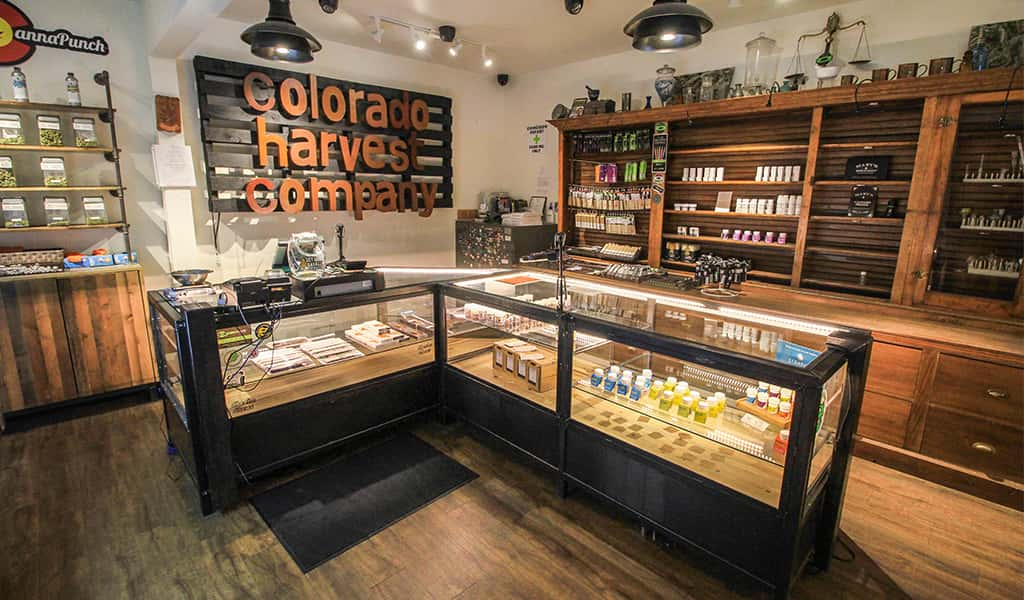
Bring your Buds, Bud – Why Data Matters for Consumers Too
Given the tight restrictions around cannabis marketing in Canada, brands have to find new and creative ways to engage with consumers. For now, packaging and branding restrictions ensure that brands trying to differentiate themselves have to rely on an educated consumer, or, where possible, have to provide consumers with the data they need to make informed purchasing decisions.
In an industry that has for decades existed in the back alleys, dark parking lots, and (literal) margins of Canadian society, data about cannabis (it’s effects, how to consume, what to consume, etc.) has largely been denied to curious consumers unwilling to operate within the Black Market. Now, those consumers (whether first timers or those returning to the plant) are faced with the daunting task of educating themselves. While some brands like Tweed and Tokyo Smoke are using their retail locations for consultations or educational sessions, not every pot brand in the country has that luxury.
“If you look at the industry in Manitoba right now, it’s kind of the Holy Grail. LP’s are in control from seed to sale, and the retail locations give brands the opportunity to connect with consumers, gather feedback in-store, and ultimately, build relationships and brand trust with consumers” says Keefe, “I think that’s one thing that Tokyo Smoke was able to do really well pre-legalization.”
Education is key
Although Tokyo Smoke’s flagship coffee shops in Toronto didn’t sell any bud (they still don’t), having a retail location gave consumers the opportunity to connect with the brand. “Where brands and LP’s have that direct interaction with their consumers, both parties win. At Tokyo Smoke we had Cannabis Yoga Night’s, classes about cooking with cannabis, even workshops on how to roll joints. When you can talk to your consumer face to face, it’s not just collecting feedback, it’s sharing information, it’s educating each other” Keefe says.
Brands that can use data to drive business decisions and educate consumers simultaneously will find themselves on the winning side of the brand battle while being at the right place, at the right time, with the right information for consumers looking to get a better understanding of this new industry. Brands using data to understand their customers know where they need to be and what they need to say to establish the relationships that will ultimately mean the success or failure of their business.

Change is neither Good or Bad. It Simply Is.
The introduction of cannabis as a new industry represents a fundamental change, full of uncertainty and opportunity. It was once said that change “can be greeted with terror or joy – a tantrum that says ‘I want it the way it was,’ or a dance that says ‘Look, something new.'”
As with all societal changes, be it technological, market-driven, moral, spiritual, political, or banal, informed decision making allows relevant stakeholders to cut through misinformation and “fake news” to make good, rational decisions. Even large, established CPG brands facing change and disruption must come to recognize the value of data-driven decision making. In a LinkedIn post, The Kraft Heinz Company President Nina Barton says that
We need to be strategic curators, anticipating and delivering on their wants and needs. Brands that step up, will win. Those that don’t, will be unseated.
Like the pioneers, explorers, and adventurers of old, marketers know that when it comes to navigating change, uncertainty, and the potential for new opportunities, having a map is a great way to make sure you get where you want to go, and you get there fast. Data is that map that can lead burgeoning new cannabis brands to the promised land of customer loyalty, brand health, and profit margins.
Godspeed.
Careers Survey Results:
Canadian's Want More Than A Pay Cheque at Work
In late August 2018, Caddle surveyed 10,000 Canadians on their careers, job seeking, the importance and impact of workplace culture, and more.

Full-time employment still most popular
When it came to employment status, full-time (54%) still outstripped part-time by far (13%) and self-employed (6%), although 10% were homemakers and 5% were retired. Among the unemployed, 4% were looking for work. People not employed and not looking for work and students tied at 3%.
In a traditional workplace setting, your title might factor into both the type of work you do and your experience overall. 31% of respondents reported they were Intermediate level, followed closely by those who didn’t categorize their title (29%). Entry level and Middle Management each came in at 15%, while Executive and Upper Management employees rounded out the bunch, each coming in at 5%.
Curiously, 23% of people didn’t name their industry, while 14% were in health care and social assistance. Educational services came in a distant third, while educational services and other (except public administration) followed at 9% and 8%, respectively.

What keeps employees happy?
Because we spend so much of our lives at work, it’s important to be happy with our jobs, and for these respondents it takes more than a pay cheque to make that happen. In fact, “I just want a pay cheque” did not even crack the top five, but “work-life balance” took first place by far at 30%, followed by “being treated with respect” at 22%. “The opportunity to help others”, “having variety and change at work” and “having my work recognized” took up the last three spots in the top five at 22%, 14% and 8% respectively.
How important is workplace culture?
We often hear about how important workplace culture is – it can affect everything from your interactions with leadership and coworkers to ever-critical work-life balance and the company’s ability to recruit new employees. 91% of respondents said workplace culture was “moderately important”, “somewhat important” or “extremely important” both to their professional success and personal happiness.
Not unsurprisingly, salary still attracted these employees to their current positions, with 22% saying the main reason they accepted their current job was because it offered a “better salary than (a) previous role.” For 16%, it was a “unique work opportunity”, while 13% “simply needed a job.”
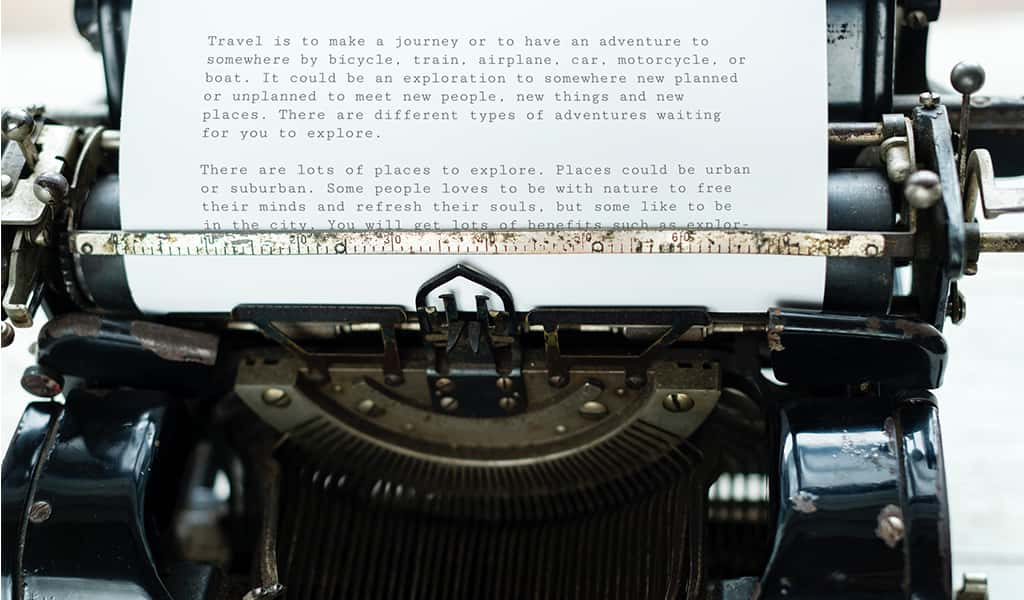
What perks and policies do employees value?
If you plan on staying in your position for the long-term, perks and policies become more important as your lifestyle and needs change throughout your time with a company. When it comes to which are most important to respondents, “Flexible hours” was the clear favorite at 29%, while “happy/friendly coworkers” came in at a distant second with 13%. “Work from home policy” netted 12%, while 11% picked “personalized benefits” and 10% were easily pleased – they just wanted a job they didn’t hate.
Are employees applying elsewhere?
If curiosity has ever gotten the best of you, you’re not alone. In fact, 52% of respondents believe it’s “completely acceptable” or “somewhat” acceptable” to apply to other jobs even if you have no intention of leaving your current job. They were split about whether it was okay to attend a job interview if you don’t have any intention of leaving your current job; 30% believed it was “not at all acceptable”, while 28% believed it was “somewhat acceptable.”
Loyalty
How restaurants are building relationships
In his classic Kitchen Confidential, the late, great Anthony Bourdain famously revealed that the best day to eat out is Tuesday – for three key reasons:
- The best chefs are off duty on Monday, return rested and ready to go on Tuesday.
- Fresh ingredients are typically delivered to restaurants on Tuesday (also Thursday and Saturday).
- Chefs prefer to cook for weekday guests than weekenders, because weekday guests are the true regulars – weekends typically track in tourists.

Restaurant Logic reinforces the importance of prioritizing regulars: they provide stable income, will champion you and recommend your restaurant to others, and are more willing to provide honest, helpful feedback to you, because they know you.
In a recent Caddle survey, 60% of respondents see loyalty and rewards programs as an important factor in their dining decision. Quality food and quality service are always important factors when it comes to food, but a loyalty program can seal the deal and help build your relationships with regulars.
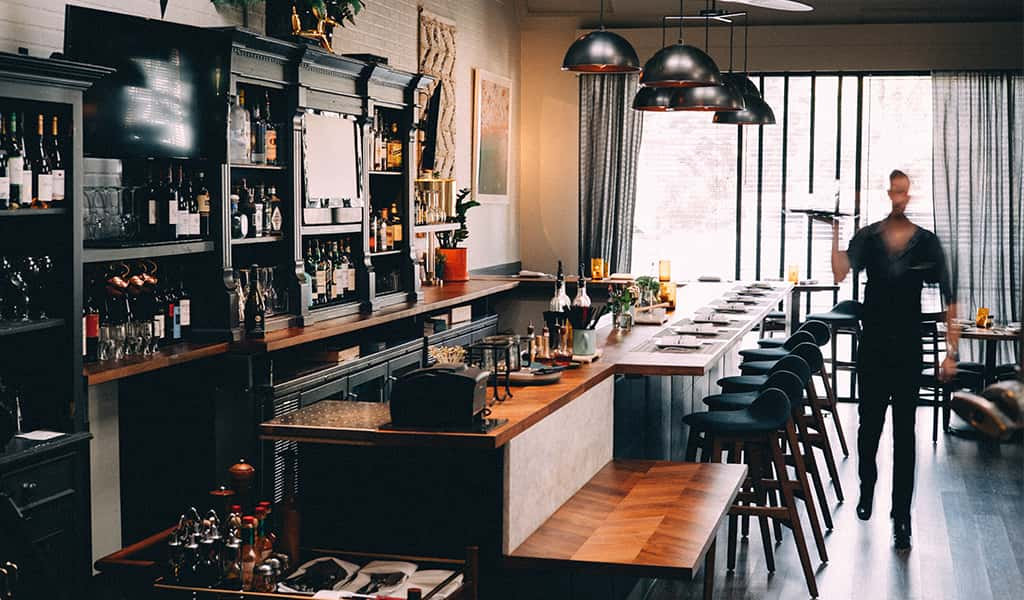
Clutch reports that loyalty members have a 26% higher annual spend, 10% increase in purchase frequency, 15% higher average order value, and 25% higher engagement versus non-members. Upserve states that 82% of loyalty members refer at least one person and spend an average of $2.14 more than non-members, which is vital in the quick service restaurant industry.
Upserve recommends offering a VIP experience to loyalty members, while Webstaurant Store suggests offering incentives such as a chance to win a free meal or gift certificate, to consider loyalty programs that integrate with your Point of Sale system, and to utilize the program to improve traffic during quieter periods throughout the week. Finally, Webstaurant recommends to make sure your rewards program is attainable, favourable, and above all else – simple.
Dollars for data
How researchers are rewarding users
The products and services we use every day are made increasingly better by the data we provide marketers, brands, and researchers. But do we deserve more?
In today’s world, everything from your puppy portraits to the route your ride share driver takes are being tracked. Sporting a step counter, pre-ordering your pumpkin spice latte on-the-go, even the sultry sounds you select on Spotify – in almost every aspect of our daily lives, meaningful data is being collected and influencing the future products and services sold back to us.

The data we provide [ideally] result in more accurate, tailored solutions provided back, but should we be rewarded further for the data we’re providing? When Caddle users were asked this, 89% said “of course!” The research and reward model is one that Caddle has helped pioneer and polish in Canada, and thanks to peers following a similar model, the world is becoming fairer for users sharing tidbits of their preferences online.
Here at Caddle, we employ a simple and effective cashback model: businesses pay to feature ads and ask questions to our users, our users collect cash for watching ads and answering questions, and we earn a small amount in handling the overall transaction and providing an easy-to-use platform. The benefits of our solution are immediate: businesses pay for ads that actually get attention, and users are rewarded for their valuable time and data.
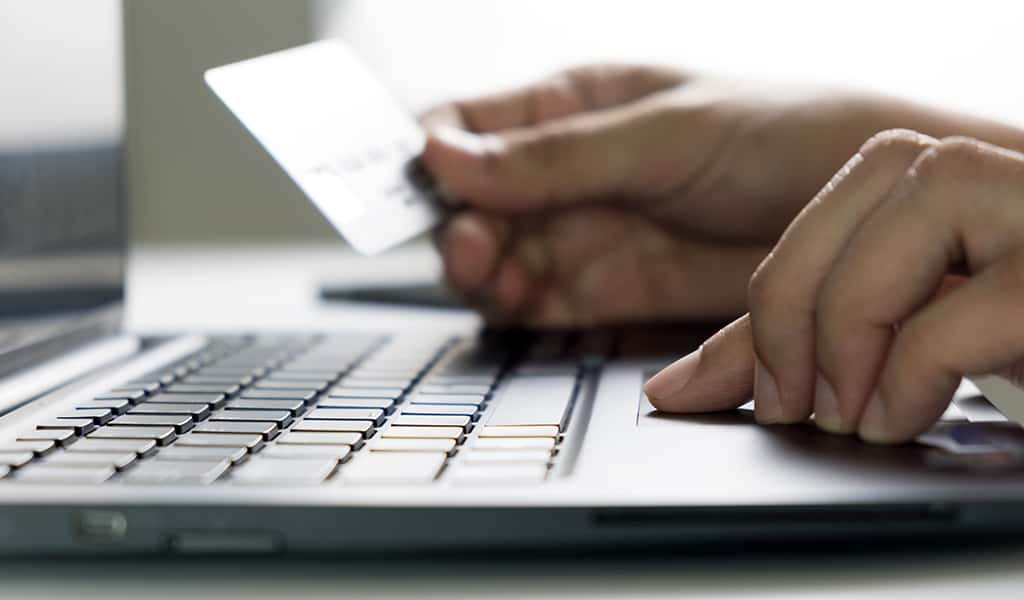
Other Canadian companies have embraced this collegial approach to data, too. Carrot Rewards focuses on wellness, integrating with fitness apps like Fitbit and then rewarding users for steps via existing loyalty programs such as Aeroplan, Petro Canada Petro Points and Cineplex Scene. Along the way, users have the opportunity to earn more rewards via surveys (commissioned by external partners), not dissimilar to Caddle.
Peer-to-peer goods trading network Bunz recently embraced both cryptocurrency and the research/reward model with the release of BTZ (pronounced like “bits”), a currency that Bunz users can use in trades or at local businesses who accept it for payment. Users can further earn BTZ by answering single-question surveys from Bunz each day.
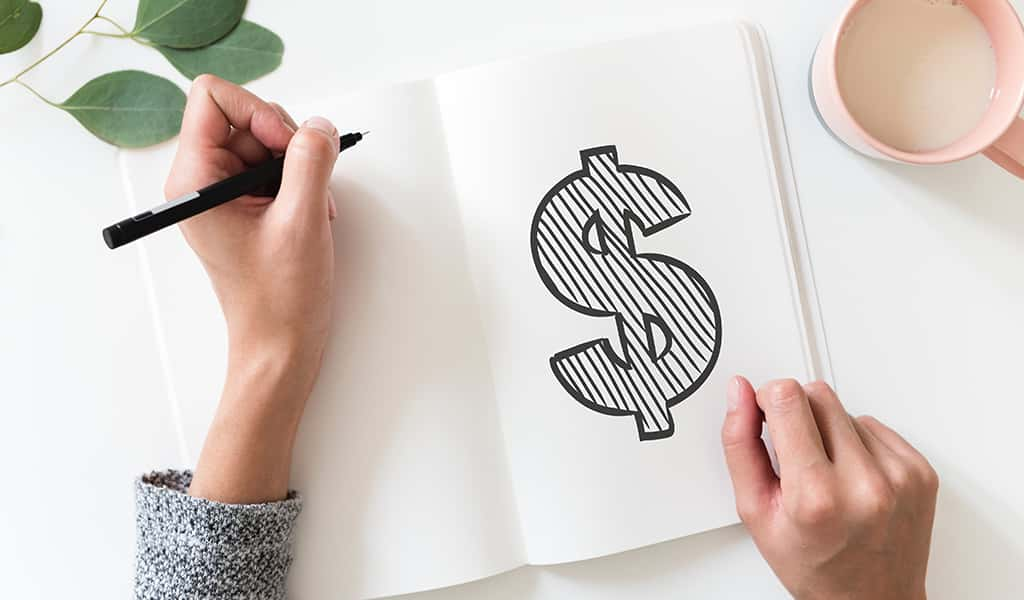
Whether or not global social media giants like Facebook and Instagram will adopt similar reward-focused research models remains to be seen, but as publications like The New York Times and The Economist are poised to help challenge the digital world, we’ll keep doing our part.
Social media sites and why it's hard to leave
Earlier this year, Caddle surveyed users on their relationships with social media and awareness of the Facebook and Cambridge Analytica scandal. Not surprisingly, Facebook remains the most-used platform among users from Boomers (64%) to Generation X (64%) to Millennials (59%), while Gen Z users are favouring Instagram at 36% versus Facebook at 23%.
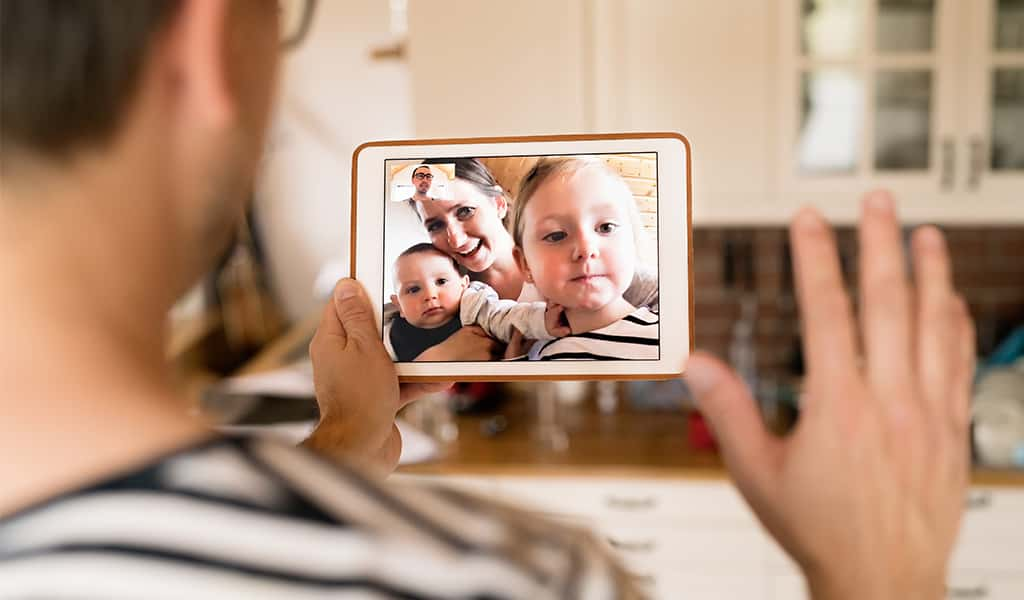
In March, USA Today reported the trend of users parting from Facebook and prioritizing Instagram for social networking. Citing Pew Research Centre, USA Today highlighted that “…800 million people log in to Instagram at least once a month, 500 million of them every day… 35% of US adults use Instagram, an increase of 7% from 2016.” This comes as no surprise to TechCrunch editor Josh Constine, who explains that, “Every social network has a half-life. Eventually parents get on it, grandparents get on it, your boss gets on it. And you don’t want to hang out with them.”
…800 million people log in to Instagram at least once a month, 500 million of them every day… 35% of US adults use Instagram, an increase of 7% from 2016.

And yet, with the dominance of Facebook and the rise of its subsidiary Instagram, many Instagram users are unaware of the connection and their privacy risks with the revelation of the Cambridge Analytica scandal. CBS News reported in April that almost 57% of Americans do not know that Facebook owns Instagram. The lack of representation regarding this relationship is purely intentional, too – to this day, there are no evident branding ties between Facebook and Instagram platforms, nor Facebook’s other biggest subsidiaries such as WhatsApp and Oculus VR. This may change with the recent exit of top Instagram executives Kevin Systrom and Mike Krieger following a contentious year between Instagram and Facebook; The Verge is predicting “the end of Instagram as we know it.”

If you’re an avid Instagram user and think you may be affected by the Facebook security breach, Tech Crunch provides a thorough guide on what to know and what to do next.
